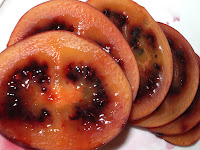I don't really have much of a story for this recipe. We wanted to have fish for dinner one night last week and Ken came up with this recipe. We chose
tilapia because it is a mild-flavored and affordable fish. Most tilapias, according to Ken who knows a lot about fish for some reason*, are omnivores. This means that they are easy to raise in fish farms and the flavor difference between wild and farmed tilapia is small.
The dish turned out quite well and the contrast between the salsa verde and the mild fish and rice was tantalizing. Unfortunately, the final pictures did not turn out as well as usual for a few reasons (which include things like pan frying instead of deep frying, which yields a less evenly coated batter; the similarly mottled appearance of each component of the final plate; over-sized portions; and an impatient and starving photographer.)

Huh. I guess I did have something to say after all. In any case, I've included a recipe below.
Spinach and Tomato Rice:

When Ken makes rice, he usually begins by sweating some small onion pieces over low heat in a saucepan with a bit of oil. Once the onions turn translucent, he adds the rice and fries it for a bit over high heat (stirring frequently). When the rice turns a sort of pearly color, then he adds the appropriate amount of water, brings the pot up to a boil, covers the pot, and puts it in the oven at 350 until it is cooked (20-30 minutes). I always used to make rice on top of the stove, but I have been completely converted to this method of making rice. Not only do you save stove space, you avoid

having to watch for boiling over and the rice NEVER burns to the bottom of the saucepan. Its amazing. If you don't cook rice this way, you should. (If you don't want onions in the rice just leave them out and lightly fry the rice before adding water.)

In any case, this rice was slightly more complicated than what I've described above. Before Ken added the water to the rice, he also added about 1 C of diced tomato and fried the tomato with the rice/onions until they were a little soft. He then added a bay leaf and the water and put the covered saucepan in the oven. Once the rice was cooked, he removed the pan from the oven and set it on the stove to cool. He opened the lid and added several large handfuls of

fresh spinach and covered the pan again. The spinach began to wilt while the rice cooled. Once the spinach was a bit wilted he tossed the spinach into the rice until evenly mixed and added salt and pepper to taste.
Salsa Verde
10 tomatillos
1 medium white onion
poblano chillies (or favorite green chili) to taste
fresh cilantro to taste
lime juice
salt
pepper
sugar to taste (very little- just enough to cut the bitterness of the lime)
Roast the tomatillos in the oven until they are soft and the skin starts to have dark spots. Let them cool and then put everything in a food processor and blend until it is of the desired consistency. Cool in refrigerator.
Pan-Fried Tilapia
To make the tilapia, ken cleaned and washed the fish and then evenly coated it with corn flakes. He lightly fried the fish in oil over the stove.
So that's all seems easy enough, huh?
It was a nice refreshing meal on a summer's day and really didn't take too long. Plus, we had mad left over salsa verde which was very nice.
*Ken wanted me to point out that "some reason" is actually that he enjoys fishing as a hobby and that it is also part of his job to know about the fish he cooks. I maintain that all of those rationales were adequately covered by the more general category of "some reason". Nevertheless, now I've explained it all and everyone feels happier. Relationships are all about compromise folks.
 Ingredients:
Ingredients: Heat the cream and vanilla bean over-medium high heat and bring to a boil. Remove from heat and allow to cool. Remove vanilla bean.
Heat the cream and vanilla bean over-medium high heat and bring to a boil. Remove from heat and allow to cool. Remove vanilla bean. until creamy and the egg yolks start to lighten in color.
until creamy and the egg yolks start to lighten in color. Pour the liquid evenly into small dishes (ramekins) and place them in a baking pan. Fill the baking pan with enough water to come up about half way around the dishes.
Pour the liquid evenly into small dishes (ramekins) and place them in a baking pan. Fill the baking pan with enough water to come up about half way around the dishes.
















































